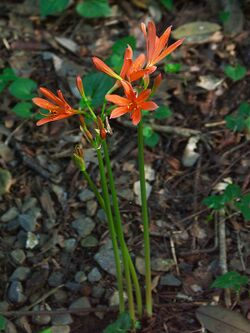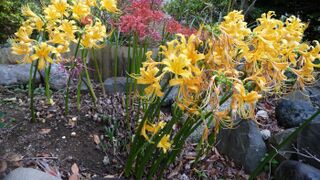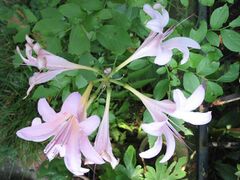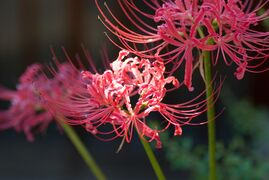Biology:Lycoris (plant)
| Lycoris | |
|---|---|

| |
| Lycoris radiata a species with long stamens | |
| Scientific classification | |
| Kingdom: | Plantae |
| Clade: | Tracheophytes |
| Clade: | Angiosperms |
| Clade: | Monocots |
| Order: | Asparagales |
| Family: | Amaryllidaceae |
| Subfamily: | Amaryllidoideae |
| Tribe: | Lycorideae |
| Genus: | Lycoris Herb.[1] |
| Synonyms[2] | |
| |

Lycoris is a genus of 13–20 species of flowering plants in the family Amaryllidaceae, subfamily Amaryllidoideae.[3] They are native to eastern and southern Asia in China, Japan, southern Korea, northern Vietnam, northern Laos, northern Thailand, northern Burma, Nepal, northern Pakistan , Afghanistan, and eastern Iran. They were imported into North Carolina and now grow wild. In English they are also called hurricane lilies or cluster amaryllis. The genus shares the English name spider lily with two other related genera.[4][5][6]
Description
They are bulb-producing perennial plants. The leaves are long and slender, 30–60 cm long and only 0.5–2 cm broad. The scape is erect, 30–70 cm tall, bearing a terminal umbel of four to eight flowers, which can be white, yellow, orange, or red. The flowers divide into two types, those with very long, filamentous stamens two or three times as long as the tepals (subgenus Lycoris; e.g. Lycoris radiata), and those with shorter stamens not much longer than the tepals (subgenus Symmanthus Traub & Moldenke; e.g. Lycoris sanguinea). The fruit is a three-valved capsule containing several black seeds. Many of the species are sterile, reproducing only vegetatively, and are probably of hybrid origin; several additional known hybrids occur.[4][5][7]
Selected species
(As of April 2015), the World Checklist of Selected Plant Families recognizes 22 species and one hybrid:[2]
- Lycoris albiflora Koidz. (treated as the hybrid L. × albiflora by some sources) – white spider lily - Jiangsu, Korea, Kyushu
- Lycoris anhuiensis Y.Xu & G.J.Fan - Anhui, Jiangsu
- Lycoris argentea Worsley - Myanmar
- Lycoris aurea (L'Hér.) Herb. (syn. Nerine aurea) – golden spider lily - China , Japan incl Ryukyu Is, Indochina, Taiwan
- Lycoris caldwellii Traub – magic lily - Jiangsu, Jiangxi, Zhejiang
- Lycoris chinensis Traub – yellow surprise lily - Henan, Jiangsu, Shaanxi, Sichuan, Zhejiang, Korea
- Lycoris flavescens M.Kim & S.Lee - Korea
- Lycoris guangxiensis Y.Xu & G.J.Fan - Guangxi
- Lycoris haywardii Traub - Japan
- Lycoris houdyshelii Traub - Jiangsu, Zhejiang, Matsu Islands, Japan
- Lycoris incarnata Comes ex Sprenger – peppermint surprise lily - Hubei, Yunnan
- Lycoris josephinae Traub - Sichuan
- Lycoris koreana Nakai - Korea, †Japan
- Lycoris longituba Y.C.Hsu & G.J.Fan – long tube surprise lily - Jiangsu
- Lycoris radiata (L'Hér.) Herb. – spider lily, red spider lily - China , Korea, Japan , Matsu Islands, Nepal; naturalized in Seychelles and in scattered places in United States
- Lycoris rosea Traub & Moldenke - Jiangsu, Zhejiang
- Lycoris sanguinea Maxim. – orange spider lily - Japan
- Lycoris shaanxiensis Y.Xu & Z.B.Hu - Sichuan, Shaanxi
- Lycoris sprengeri Comes ex Baker – tie dye surprise lily - Anhui, Hubei, Jiangsu, Zhejiang, Matsu Islands
- Lycoris squamigera Maxim. – naked lady, surprise lily, magic lily, resurrection lily - Jiangsu, Shandong, Zhejiang, Japan , Korea; naturalized in Ohio, Tennessee
- Lycoris straminea Lindl. - Jiangsu, Zhejiang
- Lycoris uydoensis M.Kim - Korea
- formerly included[2]
A few names have been coined using the name Lycoris but referring to species now considered better suited to other genera (Griffinia and Ungernia). Here are links to help you find appropriate information.
- Lycoris hyacinthina - Griffinia hyacinthina
- Lycoris radiata - Ungernia trisphaera
- Lycoris severzowii - Ungernia severzowii
- Hybrids[2]
- Lycoris × chejuensis chejuensis K.H.Tae & S.C.Ko - Korea
Cultivation and uses
Lycoris are extensively cultivated as ornamental plants in China and Japan, and also in other warm temperate regions of the world. In Japan, they are widely used at the edges of rice paddy fields to provide a strip of bright flowers in the summer, and over 230 cultivars have been selected for garden use. They are locally naturalised in the southeastern United States, where they are often called hurricane flowers, due to their blooming period coinciding with the peak of hurricane season.[8] In China, people often use them as decorations in festivals or celebrations.
Legends
Since these scarlet flowers usually bloom near cemeteries around the autumnal equinox, they are described in Chinese and Japanese translations of the Lotus Sutra as ominous flowers that grow in Diyu (also known as Hell), or Huángquán (simplified Chinese: 黄泉; traditional Chinese: 黃泉), and guide the dead into the next reincarnation.
When the flowers of Lycoris bloom, their leaves would have fallen; when their leaves grow, the flowers would have wilted. This habit gave rise to various legends. A famous one is the legend of two elves: Mañju (Chinese: 曼珠), who guarded the flower, and Saka (simplified Chinese: 沙华; traditional Chinese: 沙華), who guarded the leaves. Out of curiosity, they defied their fate of guarding the herb alone and managed to meet each other. At first sight, they fell in love with each other. God, exasperated by their waywardness, separated the miserable couple, and laid a curse on them as a punishment: the flowers of Mañju shall never meet the leaves of Saka again.
It was said that when the couple met after death in Diyu, they vowed to meet each other after reincarnation. However, neither of them could keep their word.
In commemoration of the couple, some call the herbs "Mañjusaka" (simplified Chinese: 曼珠沙华; traditional Chinese: 曼珠沙華), a mixture of "Mañju" and "Saka", instead of their scientific name. The same name is used in Japanese, in which it is pronounced manju-shage.
Some other legends have it that when a person sees someone that they may never meet again, these flowers, also called red spider lilies, would bloom along the path. Perhaps because of these sorrowful legends, Japanese people often used these flowers in funerals. Popular name Higanbana (彼岸花 Higan bana) of Japanese for lycoris is literally higan (the other or that shore of Sanzu River) flower means, decorate and enjoyable, flower of afterlife in gokuraku jyōdo (極楽浄土 gokuraku jyōdo).
Gallery
See also
- List of plants known as lily
References
- ↑ Herbert, William. 1820. Botanical Magazine 47: page 5 in commentary to plate 2113 in English
- ↑ 2.0 2.1 2.2 2.3 Search for "Lycoris", World Checklist of Selected Plant Families, Royal Botanic Gardens, Kew, http://apps.kew.org/wcsp/, retrieved 2012-04-12
- ↑ Stevens, P.F., Angiosperm Phylogeny Website: Asparagales: Amaryllidoideae, http://www.mobot.org/mobot/research/apweb/orders/asparagalesweb.htm#AllAma
- ↑ 4.0 4.1 What is the Genus Lycoris?: Taxonomy
- ↑ 5.0 5.1 Flora of China: Lycoris 石蒜属 shi suan shu
- ↑ Germplasm Resources Information Network: Lycoris
- ↑ What is the Genus Lycoris?: Species Evolution by Hybridization in the genus Lycoris
- ↑ "ENH1038/EP255: Hurricane Lilies, Lycoris Species, in Florida". http://edis.ifas.ufl.edu/ep255.
External links
- Images of Lycoris Flavon's art gallery - Amaryllidaceae
- Photo Gallery of Lycoris Juniper Level Botanic Gardens Lycoris Collection
Wikidata ☰ Q162143 entry
 |







